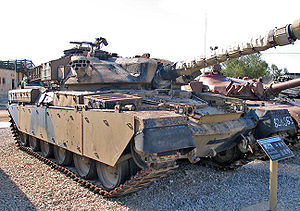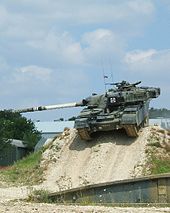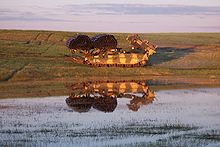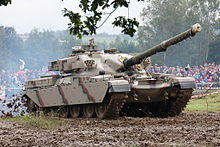- Chieftain tank
-
Chieftain (FV4201) 
Chieftain Mk 10 or Mk 11 with Stillbrew Crew Protection Package.Type Main battle tank Place of origin  United Kingdom
United KingdomService history In service 1966–1995 Used by UK, Iran, Iraq, Jordan, Kuwait, Oman Wars Iran–Iraq War, Iraq-Kuwait War Production history Manufacturer Leyland Motors Specifications Weight 55 long tons (62 ST; 56 t) Length 7.5 m (24 ft 7 in) - hull Width 3.5 m (11 ft 6 in) Height 2.9 m (9 ft 6 in) Crew 4 Armour Glacis: 120 mm (72º)[1]
Hull sides: 38 mm (10º)
Turret: 195 mm (60º)[1]Main
armamentL11A5 120 mm rifled gun Secondary
armament2 x L7 MG Engine Leyland L60 (multifuel compression-ignition)
750 hp (560 kW)Suspension Horstmann Operational
range500 km (310 miles) on roads Speed Road: 48 km/h (30 mph)
Off road: 30 km/h (19 mph)The FV 4201 Chieftain was the main battle tank of the United Kingdom during the 1960s and 1970s. It was one of the most advanced tanks of its era, and at the time of its introduction in 1966 had the most powerful main gun and heaviest armour of any tank in the world.[2] The Chieftain also introduced a supine (lying backwards) driver position, enabling a heavily sloped hull with reduced height.
Contents
Development
The Chieftain was a radical evolutionary development of the successful Centurion line of tanks that had emerged at the end of the Second World War. The British had learned during the war that their tanks often lacked sufficient protection and firepower compared to those fielded by the enemy, and that this had led to high casualty levels when faced with the superior German tanks in World War II.
In the post war period, the British Army bolstered the Centurion with the 120 mm gun Conqueror heavy tank for long range anti-tank firepower against the Soviet IS-3.
Leyland, who had been involved in Centurion, had built their own prototypes of a new tank design in 1956, and these led to a War Office specification for a new tank. The design was accepted in the early 1960s. Chieftain was designed to be as well protected as possible and to be equipped with a powerful 120 mm rifled gun. The heavy armour came at the price of reduced mobility, chiefly due to engine power limitations, which was perhaps the Chieftain's main drawback. The engine selected took the multi-fuel route and as introduced gave less than the planned output; improvements to the engine did not increase power to the desired value.
Design
The Chieftain design included a heavily sloped hull and turret which greatly increased the effective thickness of the frontal armour - 388 mm (15.3 in) on the glacis (from an actual thickness of 120 mm (4.7 in)), and 390 mm (15.4 in) on the turret (from 195 mm (7.7 in)).[1] It had a mantleless turret, in order to take full advantage of reclining the vehicle up to ten degrees in a hull-down position.
The driver lay semi-recumbent in the hull when his hatch was closed down, which helped to reduce overall height. The commander, gunner and loader were situated in the turret. To the left side of the turret was a large infra-red searchlight in an armoured housing.
The Leyland L60 engine is a two-stroke opposed piston design intended for multi-fuel use so that it could run on petrol or diesel or anything in between. In practice the engine did not deliver the expected power, and was unreliable, estimated to have a 90% breakdown rate, but improvements were introduced to address this. Primary problems included, cylinder liner failure, fan drive problems and perpetual leaks due to vibration and badly routed pipework. However, as the engine power improved the tank itself became heavier.
The tank was steered by conventional tillers hydraulically actuating onto external brake discs. The discs worked via the epicyclic gearbox providing "regenerative" steering. In reality the discs and pads became soaked in oil and diesel and the steering became difficult.[citation needed] The gearbox was operated motorcycle-style with a kick up/kick down "peg" on the left which actuated electro-hydraulic units in the gearbox; the accelerator was cable operated by the right foot. In the turret the loader was on the left and the gunner on the right of the gun with the commander behind the gunner. The suspension was of the Horstmann bogie type, with large side plates to protect the tracks and provide stand-off protection from hollow charge attack.
 Chieftain display at the Bovington tank museum, 2006
Chieftain display at the Bovington tank museum, 2006
The main armament was the 120 mm L11A5 rifled gun. This differed from most contemporary main tank armament as it used projectiles and charges which were loaded separately, as opposed to a single fixed round. The charges were encased in combustible bags. Other tank guns, such as on the Conqueror, needed to store the spent shell cartridges or eject them outside. The combustible charges were stored in 36 recesses surrounded by a water/glycerine mixture - so-called "wet-stowage". In the event of a hit which penetrated the fighting compartment, the jacket would rupture, soaking the charges and preventing a catastrophic propellant explosion.
The gun could fire a wide range of ammunition, but the most commonly loaded types were high explosive squash head (HESH), armour-piercing discarding sabot (APDS), or practice round equivalents for both types. The Chieftain could store up to 62 projectiles (though a maximum of 36 APDS, limited by the propellant stowage). The gun was fully stabilised with a fully computerized integrated control system. The secondary armament consisted of a coaxial L8A1 7.62 mm machine gun, and another 7.62 mm machine gun mounted on the commander's cupola.
The Chieftain had an NBC protection system, which the Centurion lacked.
The initial Fire-control system (FCS) was the Marconi FV/GCE Mk 4. A .50-cal (12.7 mm) ranging gun was mounted above the main gun (with 300 rounds available). This fired ranging shots out to a maximum of 2,600 yards (2,400 m), at which point the tracer in the ranging rounds burned out. The tank commander had a rotating cupola with nine vision blocks and a periscope, plus the 7.62 mm machine-gun and an infrared (IR) projector coaxial with the weapon. The aiming systems were provided for both gunner and tank commander; they had 1x or 8x selectable magnification power, and they were replaceable with IR vision systems for the night operations (3x magnification power). The left side of the turret had the big normal/ IR projector inside an armoured box. It had a relatively long range for this kind of system – up to 1–1.5 kilometres (0.62–0.93 mi).[3]
From the beginning of the '70s, the Mk 3/3 version replaced the ranging gun with a Barr and Stroud LF-2 laser rangefinder with a 10-kilometre (6.2 mi) range. This allowed engagements at much longer ranges, and also could be linked to the fire control system, allowing more rapid engagements and changes of target.
From the Mk 5 onwards, fire control was provided by the Marconi IFCS (Improved Fire Control System), using a digital ballistic computer. The upgrade was not finished until the end of 1980, when some examples (but not the majority) had the IR projector replaced with TOGS, the Termal image camera already fitted with the Challenger. Many examples had Stillbrew armour as well, meant to face Soviet 125 mm tank guns and heavy anti-tank missiles. These became the Mark 13 version. [4]
Service
Like its European competitors, the Chieftain found a large export market in the Middle East, but unlike the earlier Centurion, it was not adopted by any other NATO or Commonwealth countries.
The Chieftain proved itself capable in combat and able to be upgraded with enhancements both for overall improvement and to meet local requirements. The Chieftain tanks were continuously upgraded until the early 1990s when they were replaced by the Challenger series of tanks whose design was influenced by that of Chieftain. The final Chieftain version used by the British Army until 1995, incorporated "Stillbrew" armour named after Colonel Still and John Brewer from the Military Vehicles and Engineering Establishment (MVEE), the Improved Fire Control System (IFCS) and the Thermal Observation Gunnery Sight (TOGS).
The first Chieftain model was introduced in 1967. Chieftains were supplied to at least six countries, including Iran, Kuwait, Oman and Jordan. An agreement for sale of Chieftains to Israel was cancelled by the British Government in 1969.[5] The largest foreign sale was to Iran, which took delivery of 707 Mk-3P and Mk-5P, 125–189 FV-4030-1, 41 ARV and 14 AVLB before the 1979 revolution.[6] Further planned deliveries of the more capable 4030 series were cancelled at that point. The tank's main combat experience was in the Iran–Iraq War of 1980-88.
Specifications
- Crew: 4
- Combat Weight: 55 tons
- Overall Length: 10.8 m (gun forward)
- Hull Length: 7.5 m
- Height: 2.9 m
- Width: 3.5 m
- Powerplant: Leyland L60 (diesel, multi-fuel compression ignition) 695 bhp
- Range: 500 km
- Max Road Speed: 48 km/h
- Cross-Country Speed: 30 km/h
- Armour: turret front, 195 mm RHA (60°)
Armament
- 120 mm L11A5 rifled tank gun
- Rate of fire: 8 rounds per minute
- Elevation: -10 to +20 degree
- Laser rangefinder
- Coaxial L8A1 7.62 mm machine gun
- Cupola-mounted L37A1 7.62mm machine gun
Mark 1 and Mark 2 models had coaxial .50 cal. ranging machine guns prior to the introduction of the laser rangefinder.
Equipment
- Twin Clansman VRC 353 VHF Radio sets
- 1 C42 1 B47 Larkspur VHF radios
- 2 X 6-barrel smoke dischargers on turret
- Bulldozer blade (optional - fitted to one tank per squadron)
Variants
- Chieftain Mk 1
- 40 training vehicles for 1965/1966.
- Chieftain Mk 2
- First service model with 650 hp engine.
- Chieftain Mk 3
- Extra equipment fitted giving rise to several sub-marks.
- Chieftain Mk.5
- Final production variant, with upgrades to the engine and NBC protection system.
- Chieftain Mk.6-9
- Incremental upgrades to earlier Marks of tanks, including addition of Clansman radios.
- Chieftain Mk.10
- Mark 9 upgrade, addition of Stillbrew Crew Protection Package to the turret front and turret ring.
- Chieftain Mk.11
- Mark 10 upgrade, searchlight replaced with the Thermal Observation and Gunnery System (TOGS), manufactured by Barr and Stroud.
- Chieftain Mk.12/13
- Proposed further upgrades, cancelled when the Challenger 2 was introduced.
- Chieftain 900
- Cheftain with Chobham armour.
- FV4205 AVLB
- Bridge-laying vehicle.
- FV4204 ARV/ARRV
- Armoured Recovery Vehicle, Armoured Recovery and Repair Vehicle.
- Chieftain AVRE
- Armoured Vehicle Royal Engineers, a British Army combat engineering variant used by the Royal Engineers.
- Chieftain Marksman
- self-propelled anti-aircraft gun version, equipped with the Marksman twin gun turret.
- Chieftain Mineclearer
- Mine-clearing development.
- Chieftain Sabre
- Twin 30 mm AA turret.
- Khalid (also designated 4030P2J - P = Phase & J = Jordan)/Shir (Lion) 1
- Jordanian / Iranian variant with running gear of the Challenger 1. Basically this was a transition vehicle from the Chieftain to the Shir 2 which had been intended for Iran but was subsequently cancelled. The Shir 2 tanks became Challenger 1 tanks after reworking at ROF Leeds. The vehicle chassis comprised the front half of a Chieftain Hull, Chieftain running gear and the rear of a 4030/2 Chassis (Sloping Hull). This allowed the fitment in the engine bay of a Rolls-Royce CV8 engine.
- Weapon Carriers
- The Chieftain chassis was modified to mount air defence weapons ("Marksman" 2 x 35 mm cannon) and a 155 mm howitzer in various modifications.
- Shir 2
- Iranian variant. Visible external differences from the Chieftain Mk.5 included a sloping rear hull, Removal of the Searchlight from the left turret area and storage baskets refitted, water channel removed from around drivers hatch on the glacis plate, modified light clusters also on the glacis plate, Larger sight housing on commanders cupola.
- Mobarez Tank
- Iranian upgraded version of the Chieftain.
Operators
 United Kingdom: Used from 1965 to 1995.
United Kingdom: Used from 1965 to 1995. Iran: 707 Mk-3P and Mk-5P, 125–189 FV-4030-1, 41 ARV and 14 AVLB obtained before the 1979 revolution. Further planned deliveries of the more capable 4030 series were cancelled at that point. 100 in service as of 2005. (100 in 1990, 250 in 1995, 140 in 2000, 200 in 2002).[7]
Iran: 707 Mk-3P and Mk-5P, 125–189 FV-4030-1, 41 ARV and 14 AVLB obtained before the 1979 revolution. Further planned deliveries of the more capable 4030 series were cancelled at that point. 100 in service as of 2005. (100 in 1990, 250 in 1995, 140 in 2000, 200 in 2002).[7] Iraq: 30 tanks in service with Iraqi Army in 1990. All destroyed or scrapped.[citation needed]
Iraq: 30 tanks in service with Iraqi Army in 1990. All destroyed or scrapped.[citation needed] Jordan: 274 Khalid delivered between 1981-1985 + 90 MK5/5 From Iraq.[8] 350 in service[when?][citation needed]
Jordan: 274 Khalid delivered between 1981-1985 + 90 MK5/5 From Iraq.[8] 350 in service[when?][citation needed] Kuwait: 175 in 1976, 45 in 1989, 20 in 1995, 17 in storage in 2000.[9]
Kuwait: 175 in 1976, 45 in 1989, 20 in 1995, 17 in storage in 2000.[9] Oman: 27 delivered 1981–85.[10]
Oman: 27 delivered 1981–85.[10]
References
- Notes
- ^ a b c Richard Ogorkiewicz, Cold War, Hot Science: Applied Research in Britain's Defence Laboratories 1945-1990 (2002), p.128-129, edited by Robert Bud & Philip Gummett, NMSI Trading Ltd, ISBN 1-900747-47-2
- ^ Richard M. Ogorkiewicz, Jane's - The Technology of Tanks, Jane's Information Group, p.69
- ^ JP-4 dossier, 'Main battle tanks'(1990), p.35-36, edited by Ed.Ai. 1990, Florence
- ^ JP-4 dossier, 'Main battle tanks'(1990), p.35-36, edited by Ed.Ai. 1990, Florence
- ^ Files reveal British-Israel tank secrets BBC News 2 January 2003
- ^ "Trade Register", SIPRI, http://armstrade.sipri.org/armstrade/page/trade_register.php, (Search UK to Iran, 1950-2008)
- ^ globasecurity.org Iranian Ground Forces Equipment
- ^ "Trade Register", SIPRI, http://armstrade.sipri.org/armstrade/page/trade_register.php, (Search UK to Jordan, 1950-2008)
- ^ globalsecurity.org Kuwait Army Equipment
- ^ "Trade Register", SIPRI, http://armstrade.sipri.org/armstrade/page/trade_register.php, (Search UK to Oman, 1950-2008)
- Bibliography
External links
Post-WWII British AFVsWheeled Ferret Scout Car · Fox Reconnaissance Vehicle · Saladin Armoured Car · Saracen APC · FV1611 "Pig" · Saxon · Mastiff PPV · Husky TSVAPCs and IFVs Light tanks and
anti-tank vehiclesSP artillery Main battle tanks UK unarmoured or non-fighting vehicles - List
- Category
MBTs Light Medium Heavy Categories:- Main battle tanks of the United Kingdom
- Main battle tanks of Iran
- Main battle tanks of the Cold War
- Main battle tanks of Jordan
- Main battle tanks of Kuwait
Wikimedia Foundation. 2010.



